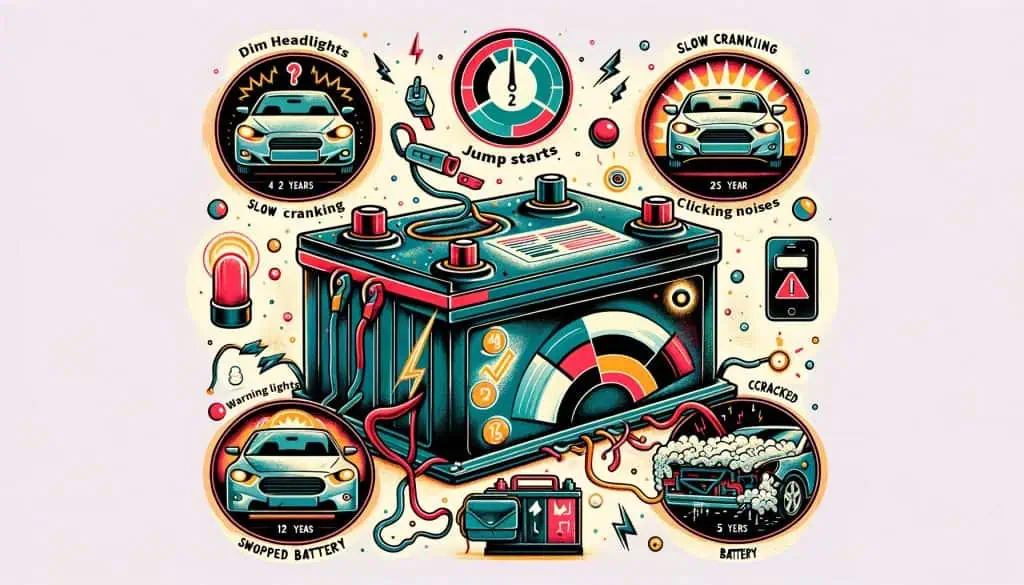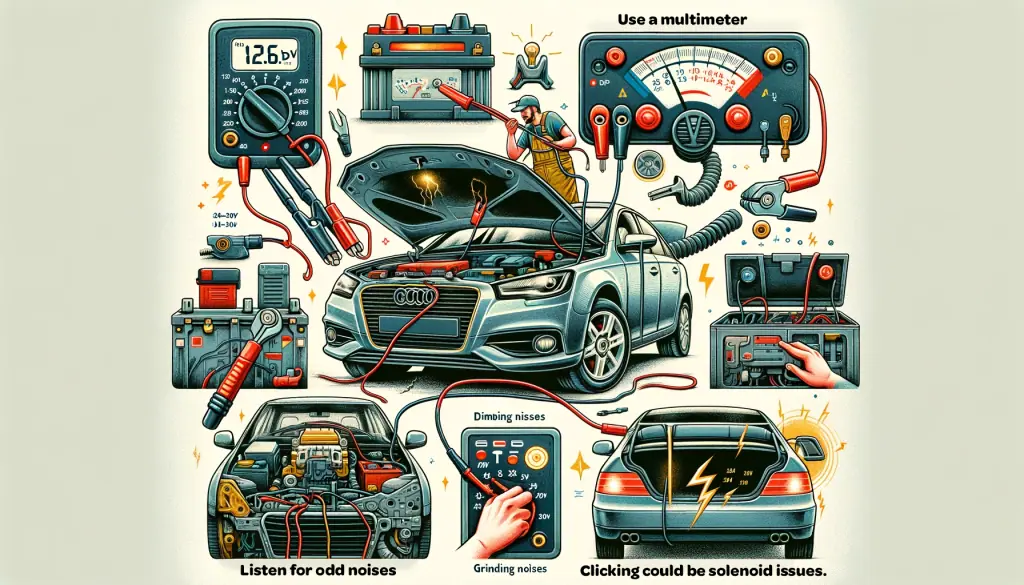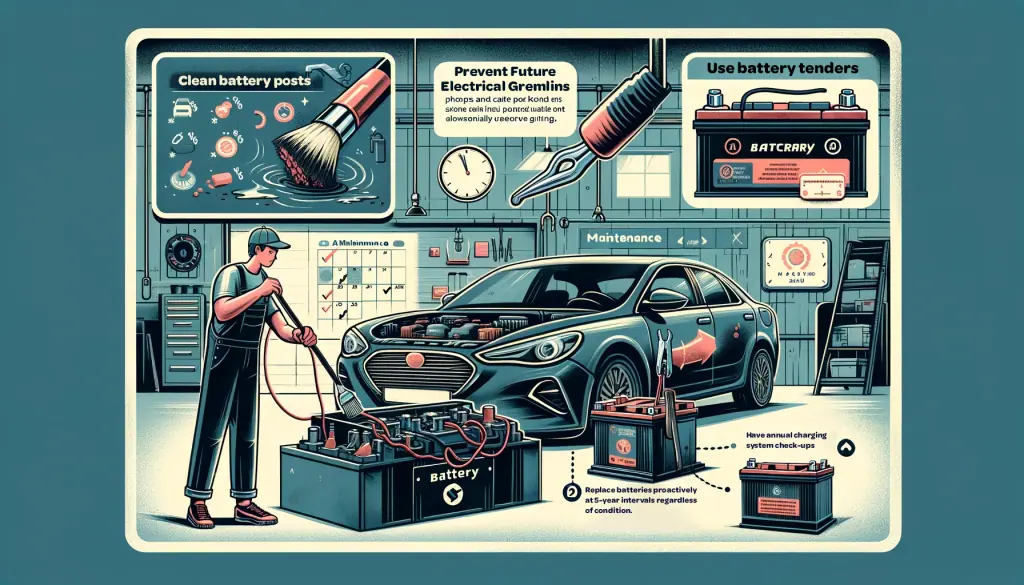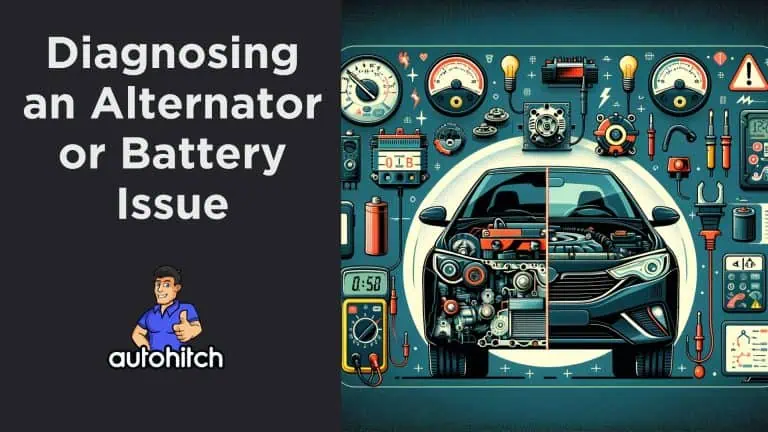Is your car struggling to start or frequently stalling?
This table makes it super easy to figure out if it’s your alternator or battery causing electrical or starting problems in your car:
| Symptom | Bad Battery | Bad Alternator |
|---|---|---|
| Engine Start | The car may start but stalls soon after | Car may start but stalls soon after |
| Headlights | Very dim or no headlights | Headlights brighten with engine rev, then dim |
| Interior Lights | Dim when attempting to start | Gradually dim while the car is running |
| Dashboard Warning Lights | Check battery light may come on | Battery/charging light or check engine light |
| Noise Upon Starting | Clicking sound | Whining, grinding, squealing noises |
| Battery Case | Swollen or bloated battery case | Not applicable |
| Smell | Rotten egg smell (sulfur) if battery leaks | Burning rubber smell from the belt/alternator |
| Voltage Check | Below 12 volts with a multimeter when off | Below 13.5-14.5 volts while running |
| After a Jump-Start | If doesn’t stay running, likely a bad battery | If runs but later stalls, likely a bad alternator |
| Accessory Function | Accessories don’t work or work very slowly | Accessories may malfunction or slow down |
| Battery Age | Older than 3-5 years, likely to be bad | Not always directly affected by age |
| Frequency of Jump-Starts | Frequently needs jump-starting | Repeatedly dead batteries |
Important Related Articles To Read:
- How often should you change a car battery?
- Where To Sell Old Car Batteries
- How to buy a car battery at Costco
- What Size Wrench For Car Battery
Table of Contents
How to Determine a Bad Battery or Bad Alternator
As a former used car dealer, I often bought cars that had been sitting idle for weeks, months, or even years, making them prime candidates for Battery and Alternator problems.
The first thing I needed to do was determine if the lack of power was due to the battery or the alternator,
because if you replace the battery and the problem is the alternator, you just wasted your money!
Using my experience, I created this guide that will empower you to confidently troubleshoot any and all charging system issues in your car.
You’ll learn to:
- Spot the distinct symptoms of a struggling alternator or battery.
- Use voltage tests and other techniques to diagnose the culprit.
- Seek cost-effective battery or alternator replacements.
- Prevent future breakdowns with proper maintenance.
Signs The Problem is The Battery

Catching battery problems early allows prompt replacements to sidestep being stranded with a dead car. Watch for these common symptoms:
- Slow or labored cranking when trying to start. A weak battery struggles to rotate the starter motor and ignition system.
- Clicking noises instead of normal cranking. This indicates critically low battery charge.
- Dim headlights or dashboard lights when the engine is off point to inadequate battery capacity.
- Warning lights like check battery or check engine illuminated on the dashboard.
- Frequent jump starts needed to get the engine running suggest charging issues between drives.
- Battery older than 5 years. Age naturally diminishes charge capacity even if not yet exhibiting other symptoms.
- Corrosion on terminals. White powdery build-up impedes electrical flow.
- Cracked or swollen case. Internal battery damage causes electrolyte leaks or gas pressure.
Routinely checking your battery posts and monitoring dashboard lights allows early detection of emerging problems.
Symptoms Your Alternator Is Failing
Since the alternator constantly works to charge the battery and run electrical components, burned out diodes and worn brushes will eventually take their toll.
Monitor for these signs of alternator demise:
- Dead battery needing jumps despite regular use. Failing alternators can’t recharge.
- Headlights or dash lights abnormally brighten or dim with engine speed fluctuations. Inconsistent charging hampers steady electrical flow.
- Check charging system warning illuminated. Sensor detects inadequate alternator voltage output.
- Electronics act weirdly. Radio static, power windows slow down. Insufficient current affects accessories.
- Growling noises from under the hood, often from bad bearings.
- Rubber burning smell if the alternator belt is severely worn.
- Excessive sparking on alternator terminals points to wiring issues.
Replacing worn brushes, bearings, diodes, or the whole alternator unit provides reliable charging once again.
Tips For Diagnosing Charging Issues In Your Car

With overlapping symptoms muddying the root cause, confirming whether it’s the battery or alternator at fault speeds repairs. Consider these handy diagnostic pointers:
- Use a multimeter to check battery voltage with the engine off (should be 12.6V) and running (13.5-14.4V). Too high or low indicates problems.
- Try jump starting. If the car runs continuously after removing jumper cables, likely just a dead battery. If it runs only while jumped, probably the alternator.
- Turn on multiple electronics (lights, wipers, stereo) and watch if this diminishes brightness or performance further. A bad alternator can’t handle heavy electrical loads.
- Closely inspect terminals and cables for corrosion or looseness impeding connections.
- Listen for odd noises — grinding suggests bad alternator bearings, clicking could be starter or solenoid issues.
Of course, you can always have free battery and charging tests done at any auto parts chain. Their load testers and voltmeters provide definite measurement of component performance.
Confirming the root of electrical troubles guides smart repair decisions.
Seeking Cost-Effective Battery or Alternator Replacements
Once conclusively pinned on the battery or alternator, swiftly swap in replacements to restore reliable starting and charging.
While batteries cost $100 on average, alternator jobs with labor run $500 or more. Carefully selecting parts delivers dependable performance at the best value:
- For batteries, match replacement specs to OEM factory units, or upgrade to absorb accessories’ added loads.
- Quality new, remanufactured, or rebuilt alternators balance cost, longevity, and OEM-level outputs.
- Buying online through retailers like AutoZone or Advance Auto Parts then installing yourself or at a shop saves money.
Of course, replacements under 3-year or 36,000-mile new car warranties mean simply heading to your dealer’s service department.
Either way, promptly addressing dead battery or bad alternator issues prevents getting stuck with a lifeless car!
Prevent Future Electrical Problems

Beyond replacing damaged components, smart maintenance helps avoid charging system troubles:
- Clean battery posts and cable ends frequently to avoid resistance from corrosion build-up.
- Ensure tight terminal connections for unimpeded electrical flow.
- For infrequent driving, use battery tenders to maintain optimal charge.
- Replace batteries proactively at 5-year intervals regardless of condition.
- Have annual charging system check-ups to catch deteriorating parts early.
With attentive care, your car’s starting and charging systems will deliver miles of trouble-free reliance.
Key Takeaways on Diagnosing Electrical Issues:
- Distinct symptoms help identify whether battery or alternator failures are causing starting problems
- Voltage tests quickly reveal if charging components are operating adequately
- Seeking professional diagnostics provides definitive bad alternator vs bad battery confirmation
- Promptly replacing damaged batteries or alternators is key to restoring reliable function
- Diligent maintenance prevents premature failures down the road
Watching for telltale signs of struggling batteries or alternators allows quick diagnosis and repair, keeping your travels reliable and worry-free.
My Closing Thoughts
Now you’re equipped to confidently troubleshoot charging system issues without wasting money fixing the wrong problem! If you have any additional comments or questions, please leave them in the comment section below!



